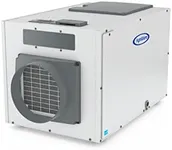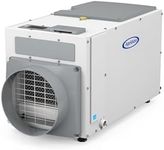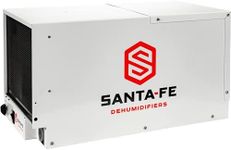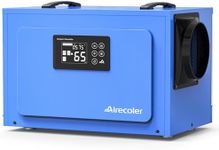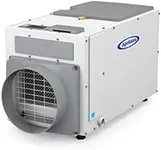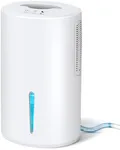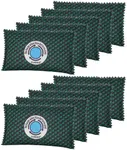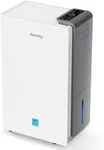Buying Guide for the Best Crawl Space Dehumidifier
Choosing the right crawl space dehumidifier is essential to maintaining a healthy and comfortable environment in your home. A dehumidifier helps to control the humidity levels, preventing mold growth, wood rot, and other moisture-related issues. When selecting a dehumidifier, it's important to consider several key specifications to ensure you get the best fit for your needs. Here are the main factors to consider and how to navigate them.Capacity (Pints per Day)Capacity refers to the amount of moisture a dehumidifier can remove from the air in a 24-hour period, measured in pints. This is important because it determines how effective the dehumidifier will be in controlling humidity levels. For small crawl spaces, a dehumidifier with a capacity of 20-30 pints per day may be sufficient. For larger or more humid areas, you might need a unit that can handle 50-70 pints per day. Assess the size of your crawl space and the level of humidity to choose the right capacity for your needs.
Coverage AreaThe coverage area indicates the maximum square footage that the dehumidifier can effectively manage. This is crucial to ensure that the dehumidifier can handle the entire space without overworking. Small crawl spaces up to 1,000 square feet can be managed by smaller units, while larger spaces up to 2,500 square feet or more will require a more powerful dehumidifier. Measure your crawl space and select a dehumidifier that matches or exceeds this area to ensure optimal performance.
Energy EfficiencyEnergy efficiency is a measure of how much energy the dehumidifier uses to remove moisture from the air. This is important for keeping your energy bills low and reducing your environmental footprint. Look for dehumidifiers with an Energy Star rating, which indicates they meet energy efficiency guidelines set by the EPA. More efficient models will use less electricity, saving you money in the long run. Consider your usage patterns and opt for an energy-efficient model if you plan to run the dehumidifier frequently.
Drainage OptionsDrainage options refer to how the dehumidifier disposes of the collected water. This is important for convenience and maintenance. Some dehumidifiers come with a built-in pump that can automatically drain water to a nearby sink or out of a window, which is ideal for continuous operation. Others may have a gravity drain option, requiring the unit to be placed at a higher level for water to flow out naturally. There are also models with a water collection bucket that needs to be emptied manually. Choose a drainage option that fits your setup and maintenance preferences.
Noise LevelNoise level is the amount of sound the dehumidifier produces while operating, measured in decibels (dB). This is important if the crawl space is near living areas where noise could be a disturbance. Dehumidifiers typically range from 50 to 70 dB. For quieter operation, look for models that are on the lower end of this range. If noise is not a major concern, you can opt for a more powerful unit that might be slightly louder. Consider the proximity of the crawl space to living areas and your sensitivity to noise when making your choice.
Size and PortabilitySize and portability refer to the physical dimensions and ease of moving the dehumidifier. This is important for fitting the unit into your crawl space and for any potential need to relocate it. Compact and lightweight models are easier to maneuver and install in tight spaces. If your crawl space has limited access or you plan to move the dehumidifier between different areas, opt for a smaller, more portable unit. Assess the available space and your mobility needs to select the right size and portability features.
Additional FeaturesAdditional features can enhance the functionality and convenience of the dehumidifier. These may include digital controls, humidity sensors, auto-restart, and programmable timers. Digital controls and humidity sensors allow for precise humidity level settings and automatic adjustments. Auto-restart ensures the dehumidifier resumes operation after a power outage, and programmable timers let you set specific operating times. Consider which features will make the dehumidifier easier to use and more effective for your specific needs.


